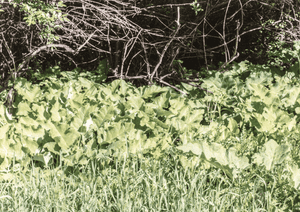“Winter pinkeye” is caused when a burdock sliver gets into an eye and leads to inflammation and infection that may puzzle your veterinarian.
February 18, 2016

When an animal comes up with an irritated, weepy, opaque eye problem in the summer, the diagnosis is pretty straightforward: It’s probably pinkeye. In the fall and winter, however, the diagnosis is more complicated.
That’s because eye problems in cattle and horses can be caused by foreign material in the eye, including burdock slivers. This plant has seeds that stick to fur or clothing, and when ripe, the burrs release hundreds of microscopic barbed slivers.
“Winter pinkeye” is caused when a burdock sliver gets into an eye and leads to inflammation and infection that may puzzle your veterinarian. That’s because, unlike cheatgrass or foxtail, the microscopic burdock sliver is not easily seen. But the problems it can cause are. The cornea may become inflamed and ulcerated; the eye may turn cloudy and have a white spot or bulge on it.
In cattle, the problem may be mistaken for pinkeye, but pinkeye is generally a summer problem when face flies spread infection from animal to animal. By contrast, burdock slivers usually get into the eye in fall or winter after burrs are ripe. A sliver may become embedded in the eyelid, where it scratches the eye every time the animal blinks, creating an ulcer on the eyeball. The sliver is so small that the usual tools used by a veterinarian to examine an eye — a focal light and magnifying lens — may not be powerful enough to locate the foreign object.
So if you and your cattle struggled with winter pinkeye this past winter, now is the time to think about controlling the burdock in your pastures to avoid the problem next winter.
Controlling burdock
Getting rid of burdock patches in a field or pasture can help prevent irritation from burrs, says Carl Dahlen, Extension beef specialist with North Dakota State University. “Spraying plants at the right time of year or chopping them down before the burrs are ripe can help. We’ve used a little tractor with a brush hog to drive through every pasture and chop down those patches.
"In places you can’t drive to, you end up chopping them by hand,” he says.

“What we call ‘winter pinkeye’ has become more prevalent, and it’s usually due to some kind of irritation." - Carl Dahlen, NDSU
“Ranchers may not be as concerned about the eye issues as just the fact that burdock takes over certain areas of the pasture. It competes and crowds out other plants, nothing else grows there,” says Dahlen.
Several broad-leaf herbicides will kill burdock if applied properly, according to Don Morishita, University of Idaho professor of weed science and an Extension specialist. Burdock flowers in late summer, producing a mature composite seedhead (burrs) by mid-August in Southern areas and later in Northern climates.
“Burdock is a biennial; it lives for two growing seasons. The first year, it doesn’t grow tall or bloom; it merely stores reserves in its roots, like a carrot [a biennial],” he says.
The second year, it grows a deep taproot and a tall stalk, producing flowers and burrs. This exhausts food reserves in the root, and the plant dies after burrs are mature. After the stalk comes up, it is harder to kill with herbicides because the plant is sending food up from the roots instead of down.
“Burdock plants are easiest to kill in early spring or in the fall. The first-year plant stays in a rosette stage that first summer [circular cluster of leaves, no tall stalk], and this is the easiest time to kill it. Apply spray when the plant is putting food into the root, since you have to get herbicide into the root to kill the plant,” Morishita says.

Burdock can spread in a pasture, taking over spots and preventing more palatable plants from growing.
Use a broad-leaf herbicide like 2,4-D that can move down into the root. If you spray early in the spring, you generally kill the new young sprouts and last year’s rosettes — the plants that are trying to create more food reserves in the roots for their big push to complete second-year growth and make burrs.
Morishita says you must spray early to get the second-year plant. If you spray in the fall, you are killing this year’s rosettes — plants that would mature and create burrs next year, he says.
“Fall is actually a good time to spray burdock, to kill young plants that are storing food reserves in their roots for next year’s growth. The first hint of cold weather is a trigger to send food to the roots,” Morishita says.
The main thing to remember when using herbicides to kill burdock or other biennial and perennial weeds is to not overdo it. “If you use too much, it quickly kills the leaves and doesn’t get down into the taproot. The root survives to regrow. You want a slower kill so the leaves survive long enough to transfer herbicide down into the root to kill the whole plant. Use the recommended rate [2% to 3% solution of 2,4-D, which is about 0.5 to 3.75 ounces per gallon of water] and spray lightly, until plants are barely wet but not dripping,” he explains.
Morishita cautions against using anything other than broadleaf herbicides. “Burdock is a bare-ground plant; it doesn’t grow well where there’s a lot of grass cover or other competing plants. Don’t use Roundup, since it kills everything, including the grass that tends to inhibit regrowth of burdock.”
Chopping burdock is effective, but you must do it at the right time or the plant will regrow. The best time to chop it is after the stalk is budding but before burrs are ripe. At that point, the food reserves are so low in the root that it cannot regrow, says Morishita.
It may take several years of diligent control to eradicate burdock, since seeds can live a long time. Even though you chop or spray the plants, there may be viable seed in the ground from earlier years that will sprout and grow. Keep checking the patches and get rid of new plants that grow up from old seeds.
Unless controlled, burdock readily spreads to new areas by burrs stuck to animals. Livestock and wildlife spread this weed to other fields and pastures. Cattle buyers may refuse to purchase animals that are covered with burrs. There are multiple reasons to try to eliminate these noxious plants in your pastures.
Why winter pinkeye is hard to diagnose
Dahlen says it’s hard to know how many cases of “pinkeye” are actually pinkeye. “All we see are signs of an irritated eye and an ulceration,” he says.
“What we call ‘winter pinkeye’ has become more prevalent, and it’s usually due to some kind of irritation,” he says. “Whenever you have a lot of cows in one place during winter, there can be a combination of factors, such as eye irritations and having the right ‘bugs’ in place, and it can look like an outbreak of pinkeye,” he says.
It might be wind blowing dust or chaff into the eye, or something like burdock getting caught under an eyelid. The scratch on the cornea allows access by pathogens, causing an eye infection.

Breathtaking photos of winter on the ranch
The first snow hit parts of the Midwest this week. Mentally prepare for the winter wonderland with these stunning photos. See photos here.
“Infectious eye problems can happen without flies if cattle are confined, rubbing on each other. It might not be the same organism that causes summer pinkeye, but it might be somewhat contagious,” says Gerald Stokka, veterinarian and professor of livestock stewardship at North Dakota State University.
Hard to see
Burdock slivers are harder to find than most plant material. “You must be diligent in your search, and the animals don’t like you doing that. It helps to have the animal restrained in a headcatch, with a halter to pull the head to one side. Then use your fingers to peel back the eyelids and take a look both top and bottom, and in the front where the third eyelid is located, to see if you can find anything foreign,” says Stokka.
“I often use a tissue or lens paper to try to wipe something out of the area. Even if I can’t see anything, I’ll still wipe it. Sometimes I’ve been successful, even when I can’t identify anything there, just by wiping the area. This might pull it loose and get it out of there if it’s a tiny particle like a burdock sliver. There is a lot of pain, and it will give the animal relief if you can remove the foreign body or wipe it out of the eyelid,” he says.
“If I think there’s an infection in that eye, I’ll prescribe an antibiotic. An irritated eye waters a lot and washes the antibiotic out. We can’t keep repeating topical medication with cattle so we use a systemic antibiotic in hopes it will get into the bloodstream and tears, and be applied over the eyeball via tears,” Stokka says.
Burdock can be a frustrating problem, as can hay containing cheatgrass or foxtail. Burdock burrs occasionally get baled up in hay or straw, and when the burrs get broken up in hay or bedding and float around in the air, tiny slivers can end up in the eyes.
Heather Smith Thomas, a rancher, writes from Salmon, Idaho.
Can you use snow as a water resource for your cattle?
100+ spring calving photos from readers
It's hay time! 10 new mower conditioners in 2016
Wendy's addresses antibiotic use in beef production
9 new pickups for the ranch in 2016
15 best winter on the ranch photos
Calving Checklist: Everything you need to know & have before calving
Does it really take six years to cover your costs on a cow? NO
You May Also Like



